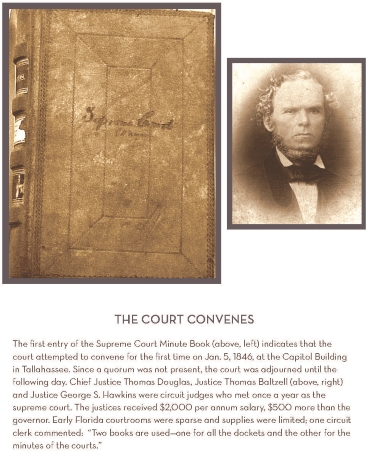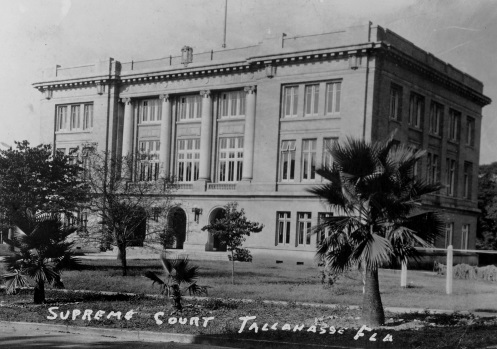- Home
- Court History
History of the Florida Supreme Court
The Historical Society Role in the Courts HistoryThe history of the Florida Supreme is rich and colorful, a vital part of the Historical Society's mission to honor and preserve the important artifacts of institution for future generations. Listed on the navigation to left are a few of the projects that the Society has be involved is along with other interesting pieces of the Court's history. THE HISTORY OF THE FLORIDA SUPREME COURTWhen Florida became a State in 1845, the Constitution previously proposed by the Territory of Florida in 1838 became the state's first Constitution. Interestingly, the 1838 Constitutional Convention was held in Port St. Joe, on the Gulf coast southwest of Tallahassee. A museum in Port St. Joe commemorates these events. This Constitution created a Supreme Court but gave it no Justices of its own. The powers of the Court were vested in the judges of the circuit courts (the name Florida gives to its trial courts). The circuit judges were elected by the Legislature, collectively serving in the capacity of Justices of the Supreme Court from 1846 until 1851. During this period, there were four judicial circuits in the state; therefore, the maximum number of circuit judges serving as the Supreme Court was four. The circuit judges sat as a body to review the decisions of the individual members. The First JusticesIn 1848 the Constitution was amended, and in 1851 authorizing acts were passed providing that the Supreme Court should have its own Justices -- a Chief Justice and two Associate Justices. These Justices were elected by the State Legislature for the  term of their "good behavior." In 1853 an amendment provided for the election by the people of the Justices for six-year terms. The 1861 Constitution provided for the appointment of the Justices by the Governor, with the advice and consent of the Senate, to serve for six-year terms.
In 1868 following the Civil War, a new Constitution was adopted calling for a Chief Justice and two Associate Justices to be appointed by the Governor and confirmed by the Senate. These Justices were to hold office "for life or during good behavior." The 1885 Constitution provided for the election by the people of three Supreme Court Justices to serve six-year terms. In 1902, an amendment increased the Court's membership to six Justices and permitted the Legislature for the year 1905, and for subsequent years, to provide for three to six Justices to serve terms of up to six years. In 1911 the Legislature reduced the number of Justices to five. In 1923 the number was again raised to six and continued to be six until a 1940 constitutional amendment, which called for seven Justices, the present number. The 1885 Constitution provided that the Chief Justice of the Supreme Court be designated by lot. A constitutional amendment in 1926 provided that the Chief Justice be selected by the Justices of the Court; this is the current method of selection. If the Chief Justice is unable to act for any reason, the Justice longest in continuous service -- also called the Dean of the Court -- acts as Chief Justice. The Meeting Place and TimePrior to 1868, the Supreme Court met where and when the Legislature provided. The Constitution of 1868 provided that the Court hold three terms a year "at the seat of government." In the Constitution of 1885, there was a similar provision, except that the The Court appoints a clerk, a marshal, and a librarian to assist in its judicial duties. In addition, each Justice has assistants who are attorneys called law clerks. Interestingly, two former law clerks returned to the Court as Justices. They were James C. Adkins and Wade Hopping. The History of the Florida Supreme Court on this page is from www.floridasupremecourt.org/ |
 number of terms could be regulated by law.
number of terms could be regulated by law. 